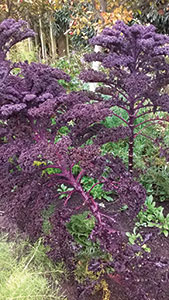As a relief from all that Christmas stodge, kale is a well textured and welcome fresh green taste. It is easier to grow than hearting cabbage, has a long harvest period and adds colour and structure to your garden through the winter.
Most varieties on sale taste and grow well. Redbor f1 is a favourite because of its beauty. Dwarf Green Curled is a smaller plant 18” high. Black Tuscan is a dramatic plant, yielding well in autumn but less over the winter. We prefer the curly kales to the flat leaf ones because of the added leaf texture, although Red Russian, aka Ragged Jack, an ancient variety from the mists of time, looks dazzling after Christmas as its leaves metamorphose from green to varying reds and pinks.
 Date of sowing and spacing give you scope for large or small plants. Best sown in modules for strong germination, you can transplant them in June or July for winter use. 24” spacing for large, down to 15” for smaller plants. If you transplant later than July you will have a very small plant by winter.
Date of sowing and spacing give you scope for large or small plants. Best sown in modules for strong germination, you can transplant them in June or July for winter use. 24” spacing for large, down to 15” for smaller plants. If you transplant later than July you will have a very small plant by winter.
Small plants only produce small pickings of little leaves. Less productive but a fine cooked delicacy, especially those of Cavallo Nero (Black Tuscan) which can also be eaten raw in salads, adding a peppery bite.
Large plants can provide good crops all through a mild winter like this one. You can pick quite large leaves from the top third of the plant. There will be far more to eat if you leave the smallest leaves at the top to grow on.
Pests are, for some reason, less attracted to kale. Blackbirds often eat all the leaves off young plants, using netting or fleece will protect until larger. Caterpillars prefer cabbage to kale most years, but even if they do decimate the leaves in August, the plant will completely re-grow in late September and crop well later. Pigeons much prefer purple sprouting and spring cabbage leaves in the winter, but if your kale is the only brassicas around they may eat all young leaves unless you net.
Collapsing plants annoy my sense of order, this is avoided mostly by transplanting the stems as deep as possible, and not using nitrogen feed—lots of compost in the soil makes a sturdy and strong stem that stays up. Lots of sunshine helps too, but my plants are slowly collapsing in the soft wet winter soil.
As the days get longer the plant sends out side shoots and flower buds. We have stopped growing purple sprouting and eat kale sprouting, smaller but equally delicate and tasty. Each time you pick, several more smaller shoots emerge, fiddlier to pick and progressively tougher to eat.
And what does the vegetable gardener get when she drops her huge carrot on her foot? A Mistletoe.




